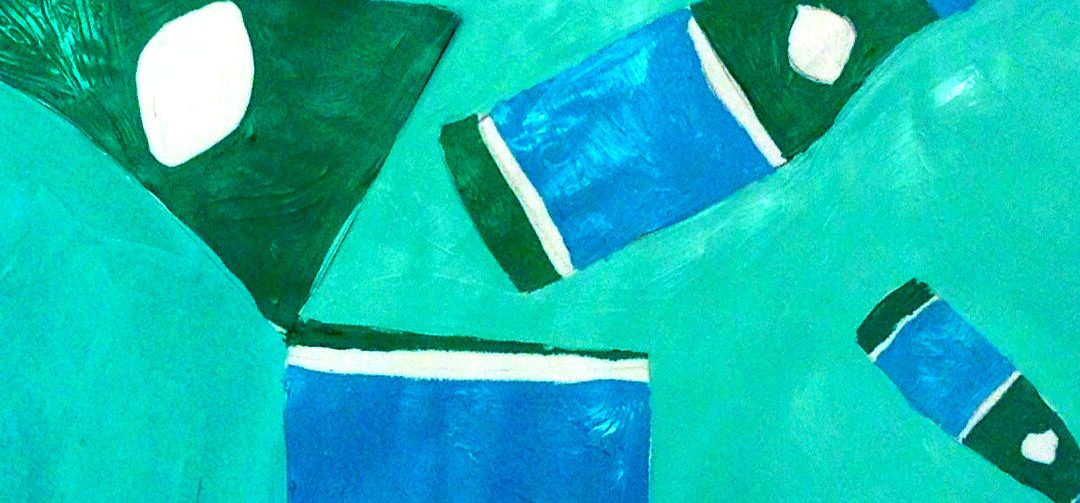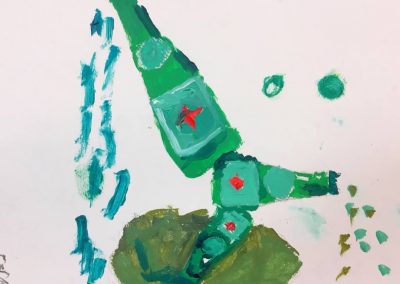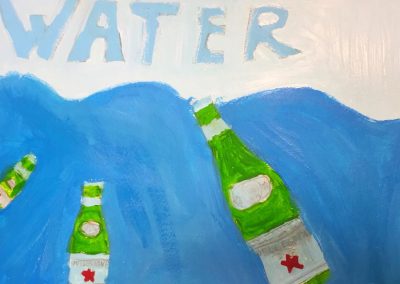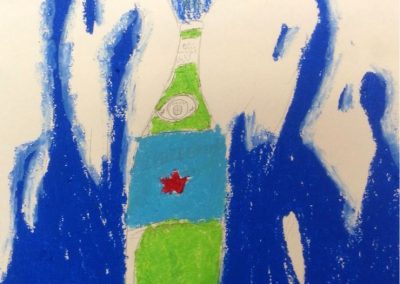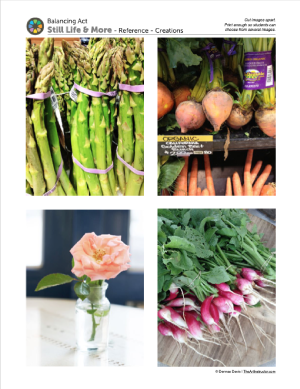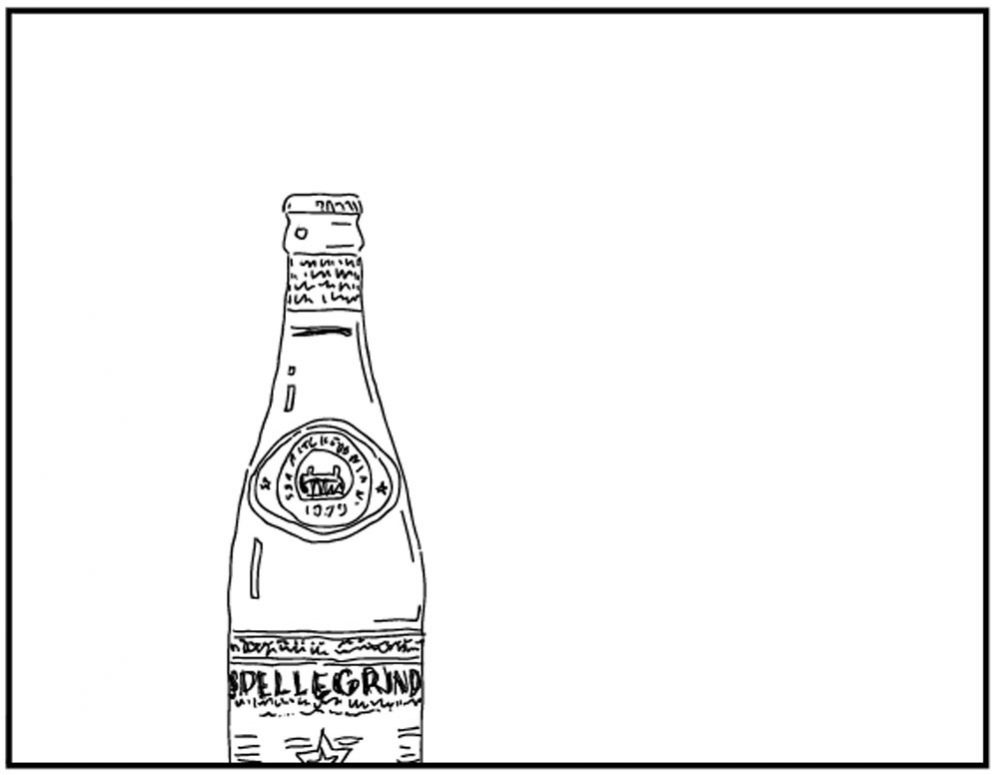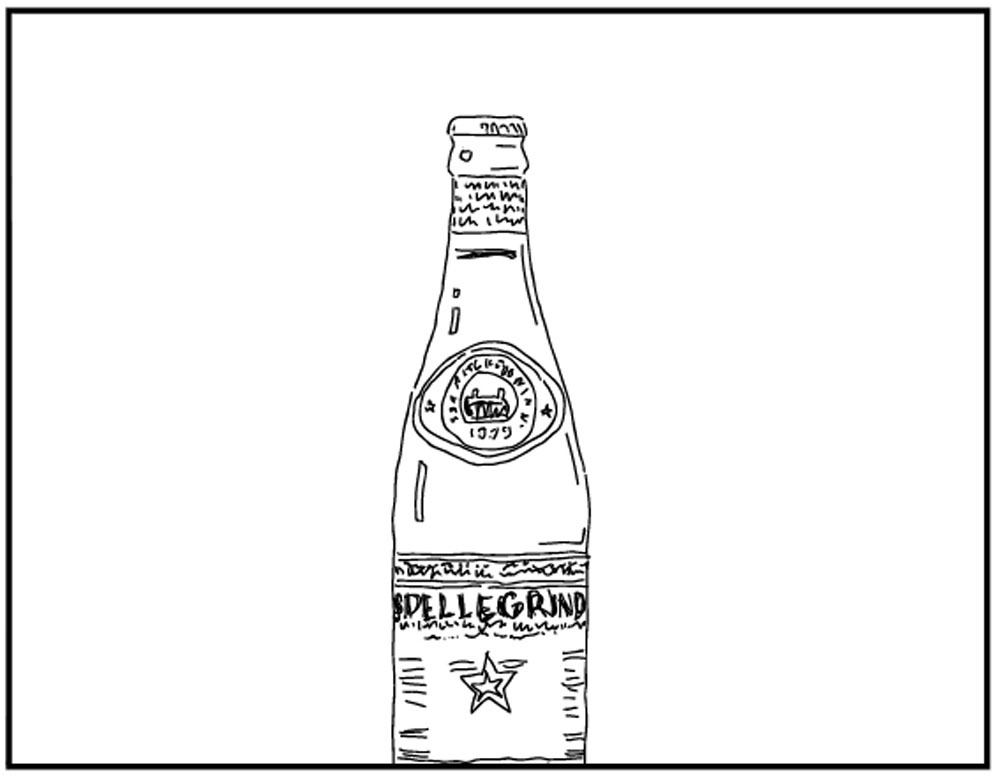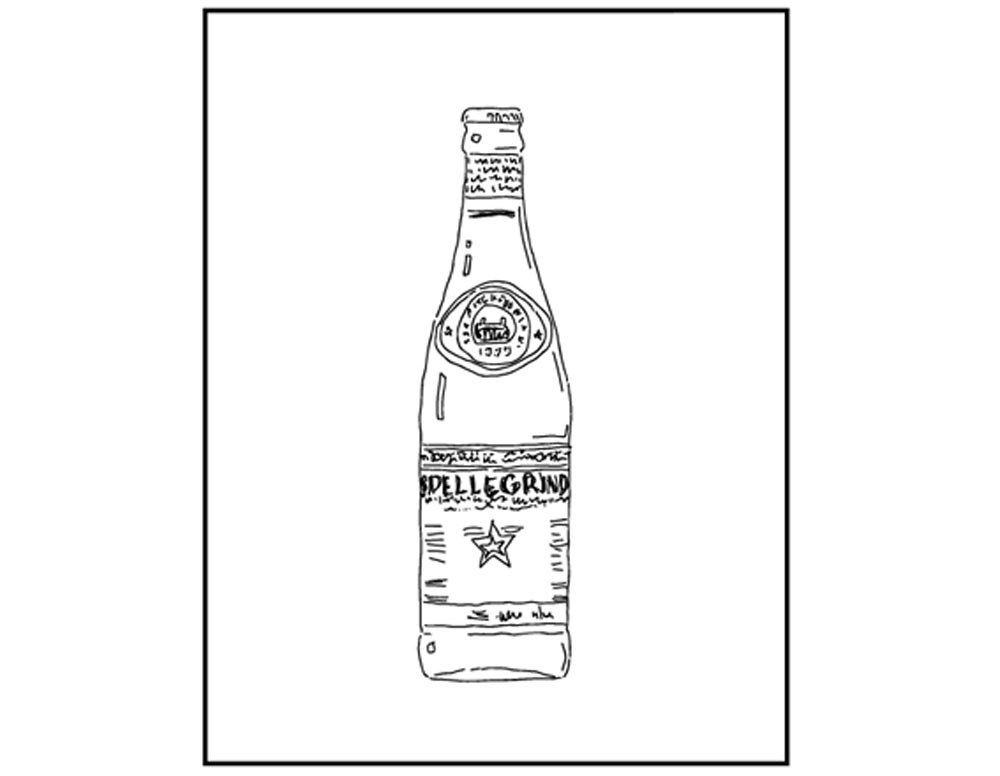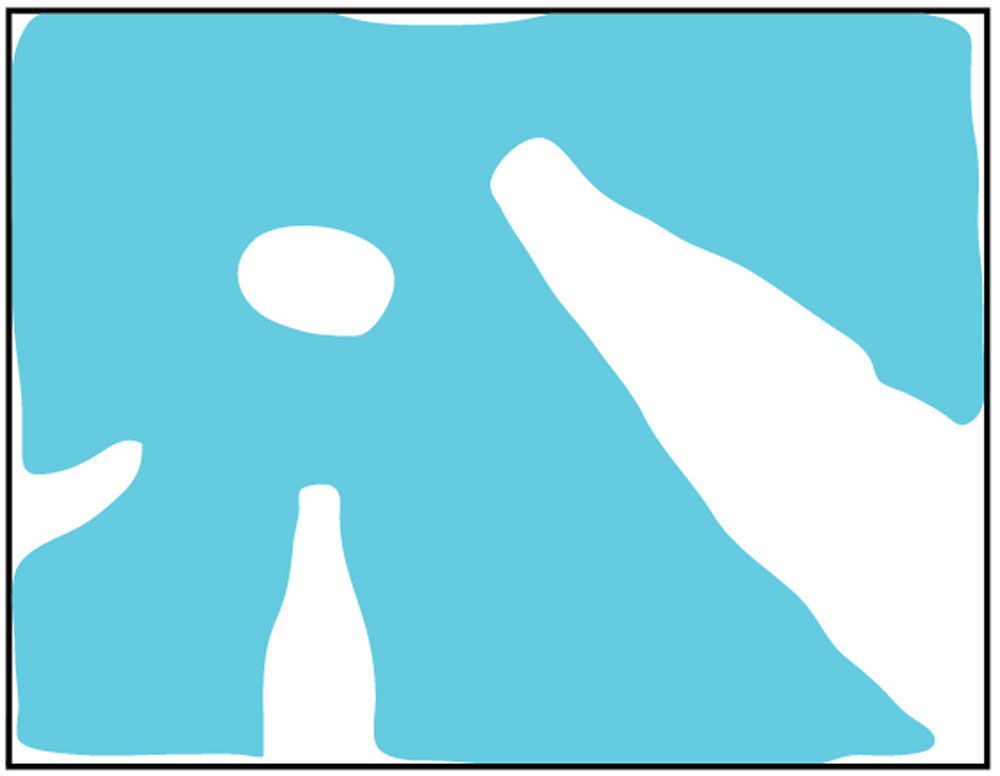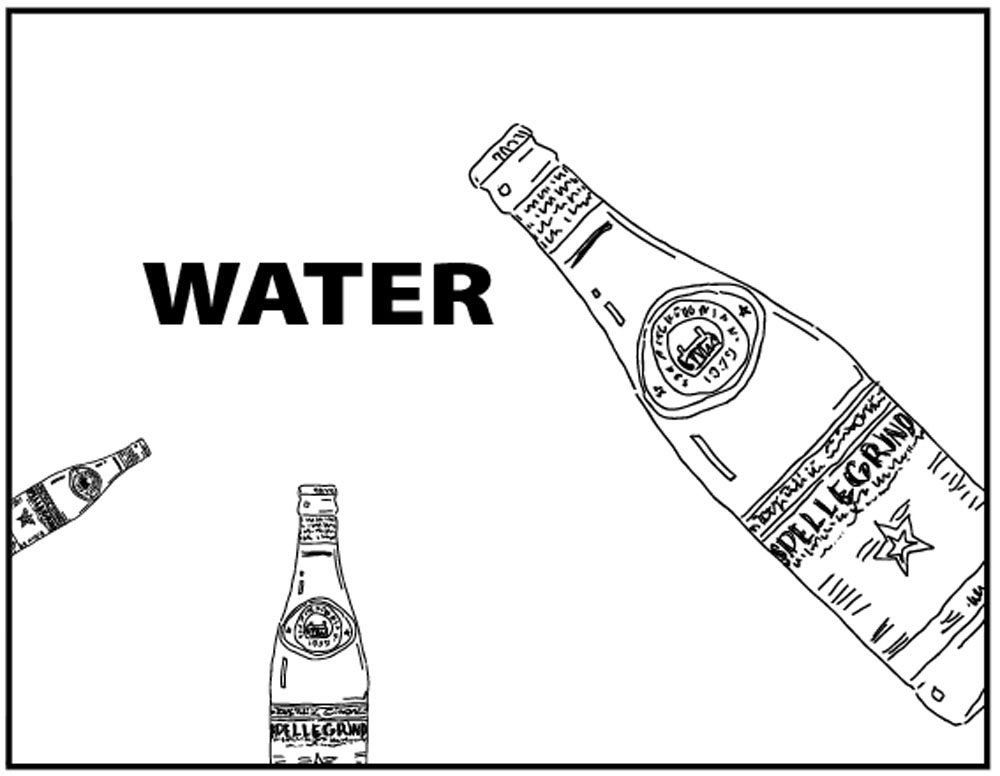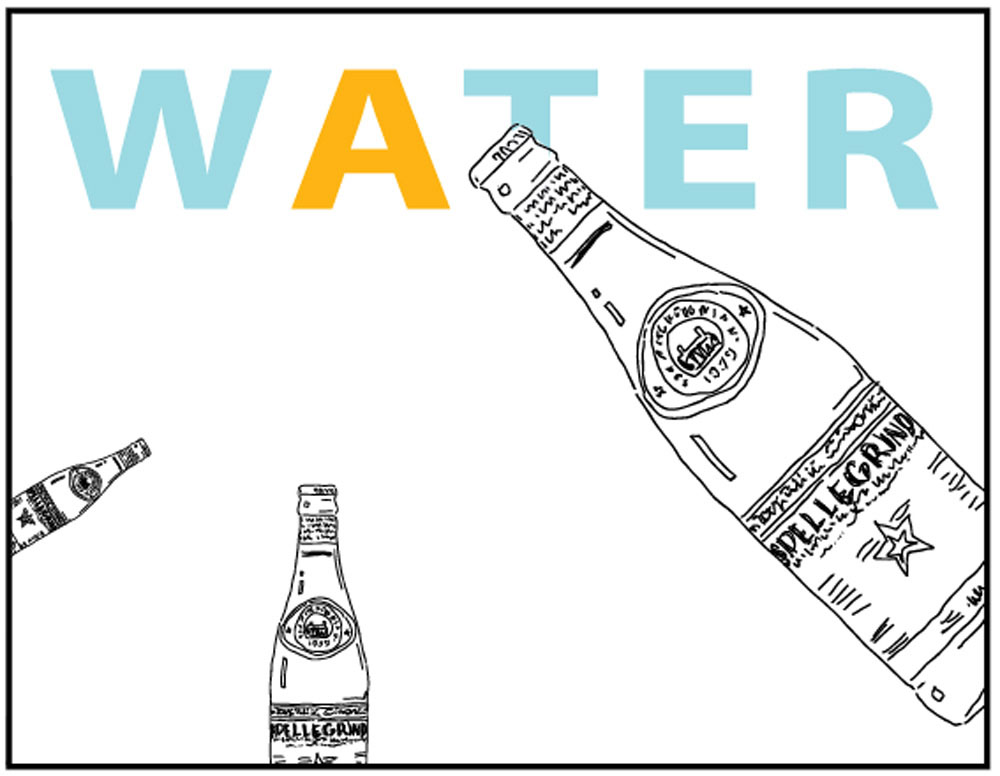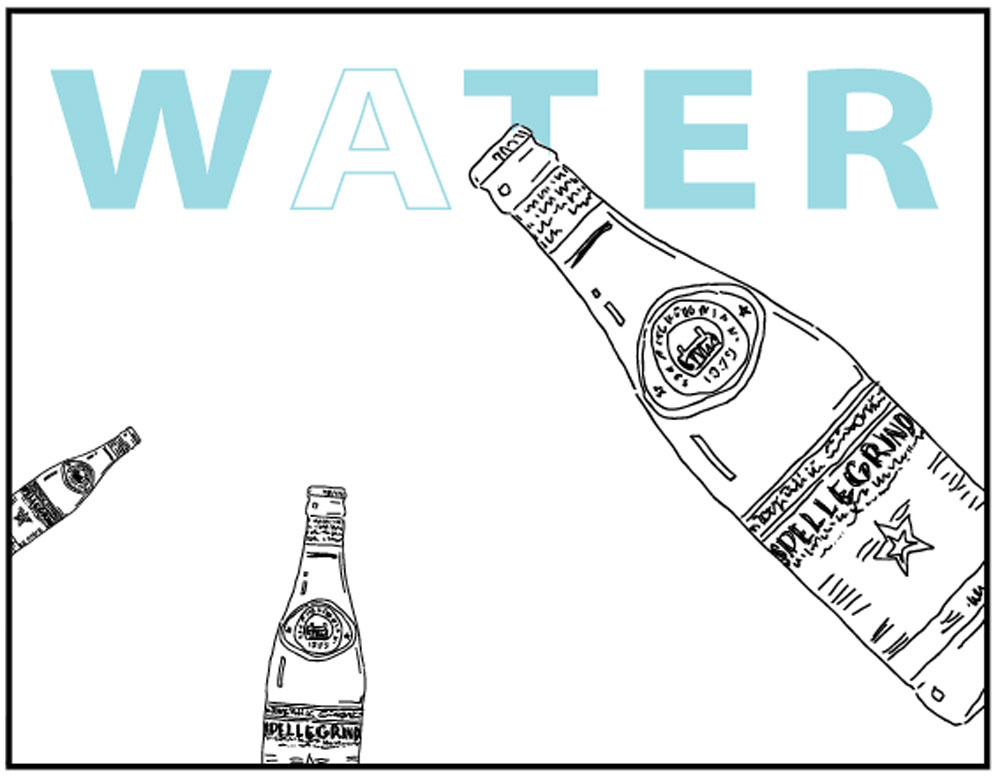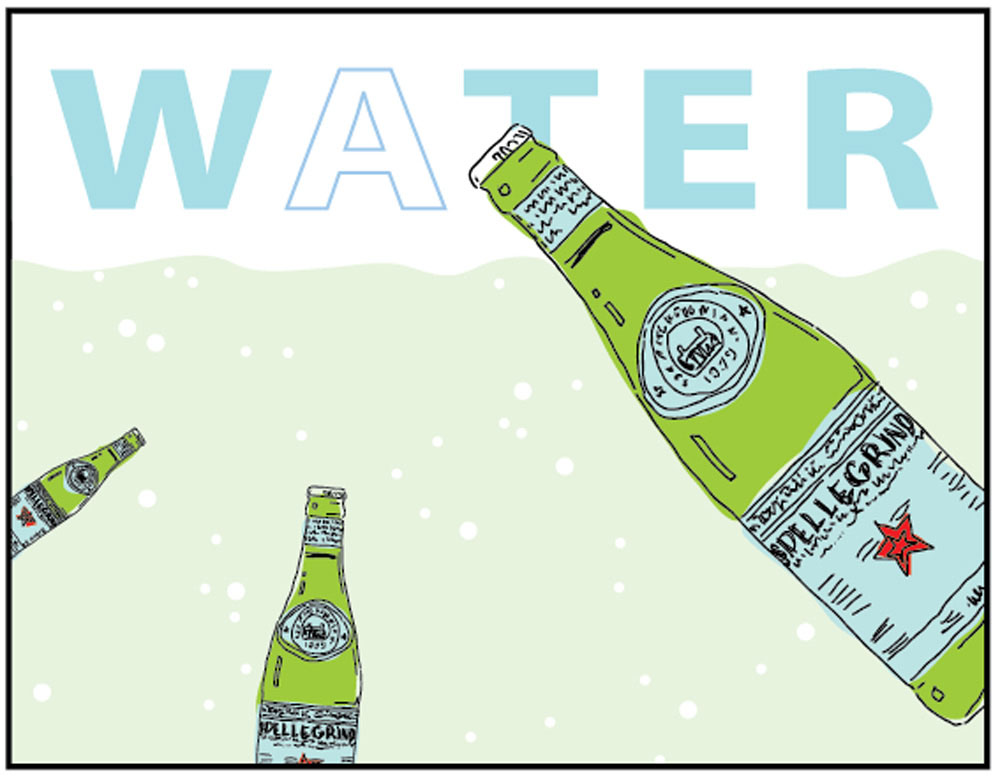Style
Each lesson Plan focuses primarily on one of the 4 Cornerstones of Art:
Drawing | Painting | Color | Style
OVERVIEW
Students will see how balance affects composition by using a drawn object and moving location and sizes. They will finish a color practice composition using acrylic paint over a drawing on paper. There will be a preview of next week’s cylinder lesson, and we will tap into students’ recent experience in creating magazine covers as well.– – –
Grades 3 – 5
Week of January 6 – 10
1 Hour & 45 Minutes
New Updated Lesson Plan!
Lesson At A Glance
Here’s a brief overview of the complete lesson. It’s also on your prep page in the Ready, Set, Go! section (below the lesson).
Colored buttons jump to each section in the full lesson plan below.
15 Minutes –Draw shells using simple lines
5 Min – Students cut out their shell sketches
5 min – Composition and Balance slideshow
10 min – OPTION: draw more shells
12 min – Students try different compositions & choose one
5 min – Set up for acrylic painting
10 min – Artists draw final composition guidelines
35 min – Students paint composition
2 Min – Everyone helps
Use this button to jump down to the preparation section.
SCROLL & TEACH
LESSONPLAN
Each section is a different color. Read over once and then you can SCROLL & TEACH using any device you like. It’s designed to work well with your phone.
LEARNING TARGETS

Students know how to draw using a reference
M A T E R I A L S
- 14″ x 17″ sketch pad
- 4B pencil
- White and kneaded erasers
- Cheasel reference stand & clip
- Shell reference PDF (below)
All materials are suggestions and may be modified as you see fit. We have tried many items, and these seem to allow the most versatility for the cost.
1.1 Print
Reference
Shells Reference
Cut images apart and print enough for each student
Hand out reference prints, or set them out and let students choose one they like.
1.2 Teach
Today’s project is all about making your work look as good as possible. This is called design, and it means that there are good arrangements for your artwork, and there are not so good arrangements. You always want to find one of the best arrangements, so your art looks great.
Artists use something called the elements of design to help figure things out. They really work. We’ll be learning about these design elements as we work with arranging the shells you’ll be drawing. Your artwork today will have 3 or 5 shells. You get to choose which ones you want.
1.3 draw
Explain to students that they should warm up with simple outline drawings of the shells and the patterns on them. That means do not add any shading at all. Students can draw any size that is comfortable, but discourage giant drawings that only have one on a page. They should be able to draw lots of smaller shells on one sheet.
It’s always ok to start over. Remind students to look at the Big Shapes first, instead of all the details. Then fill in details after the shell shapes look accurate.
As they work, display the graphic below, and read the teacher talk to explain.
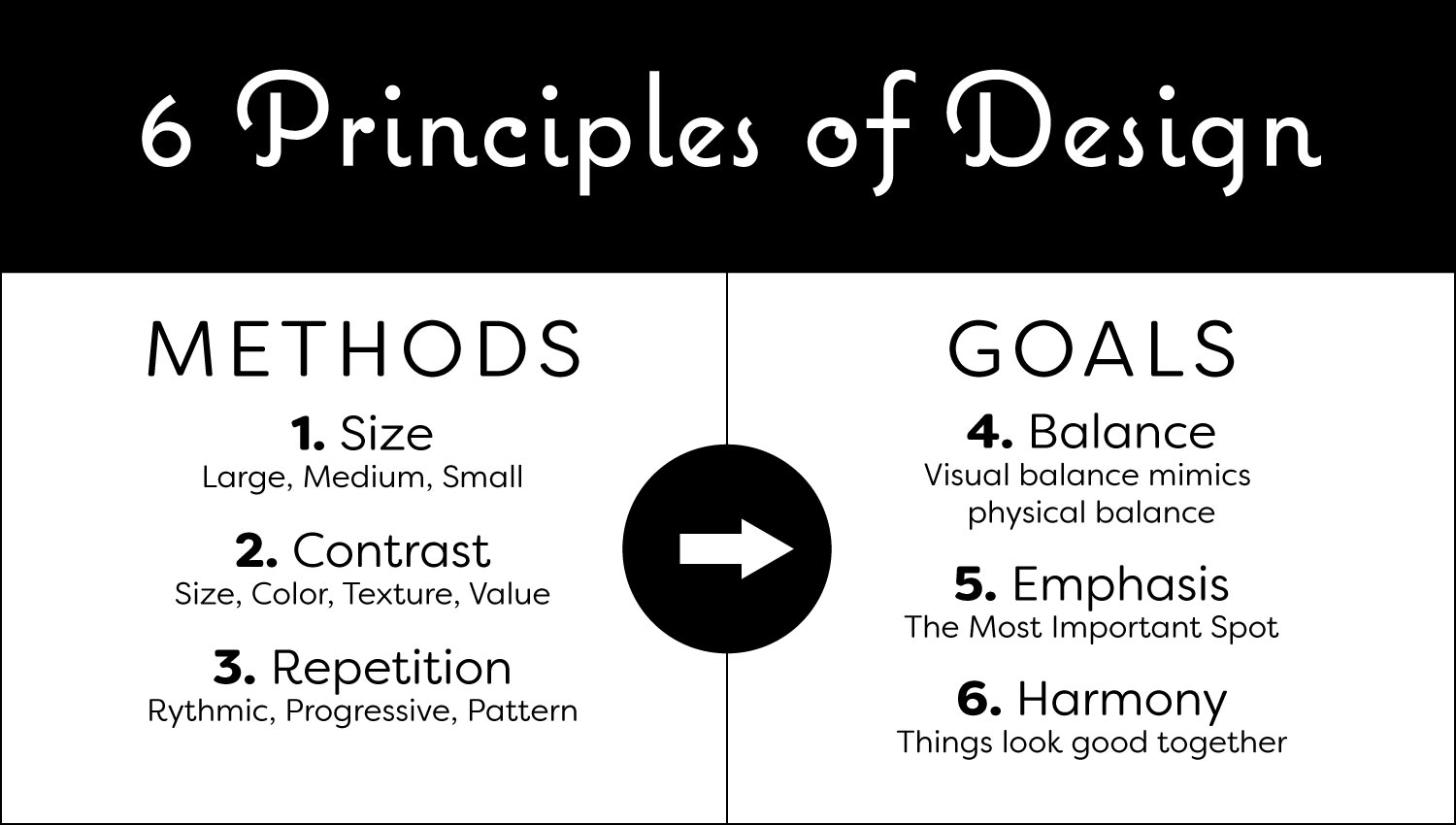
“There are 6 elements of design. 3 of these are METHODS that artist use to reach 3 GOALS that all art needs.
One of the 3 goals for your art is balance. This is important, because we don’t like to see things that look like they’re about to fall over.
By itself, a bottle has balance. You could fold it down to middle and it’s almost a mirror image of itself on each side. Things get a little more complex with shells, but this will be pretty easy and a lot of fun.
We’re going to use size, contrast, and repetition today, in order to achieve balance in our compositions.”
Advanced Student Lesson
CREATIONS - tap here to open
Our Creations lessons are for students who have completed the two years of Foundations and are ready to begin using all that they have learned to create new work. These more challenging versions of the same concepts and techniques are easily taught along-side students in the Foundations course. This allows for excellent review, and is encouraging for students to see progress from each viewpoint.
Use the Student Instructions printout below to distribute to your Creations students. Tap the image to open the PDF in a new window.
Balanced Still Life
Overview: Advanced students will use thumbnails to work out a balanced composition for a still life. They can choose to work in pencil, oil pastels, watercolor, or acrylics on paper.
Optionally, students can create a graphic-like poster painting using their own subject or from the provided reference photos. Ideas should not take more than 20-30 minutes.
Other elements such a simple poster text may also be added.
Step 1. (10 minutes) Set up objects for a still life, keeping the objects simple. At least 3 objects must be used. Select medium – and surface: either drawing paper or watercolor paper.
NOTE: Your work can be: 1) graphic-style poster with the objects isolated and arranged in any way you like, 2) surrealistic, or 3) realistic.
Step 2. (15 min) Thumbnails – Draw 3 or 4 horizontal Frames and 3 or 4 vertical ones. These should be 1 and 1/2 inches or so. Then create 6 to 8 compositions using only Big Shapes, and taking only one minute to do each idea. Take your best idea and create 1 or 2 variations of it. Choose your favorite.
Step 3. (5) Set up workspace and materials.
Step 4. Guide Lines – draw very light simplified shapes to help your accuracy and to copy the thumbnail sketch. Look at the Frame edges to make sure you’re getting the shapes the same sizes and proportions.
Step 5. Create your artwork.
Use this button to jump down to the preparation section.
LEARNING TARGETS

Students know how to make preparations for creative work
M A T E R I A L S
- Shell drawings from Step 1
- 4B pencil
- Scissors
All materials are suggestions and may be modified as you see fit. We have tried many items, and these seem to allow the most versatility for the cost.
Use this button to jump down to the preparation section.
LEARNING TARGETS

Students know how to analyze and modify a composition
M A T E R I A L S
- TV or Ipad to show slideshow
Composition and Balance (tap any image to open viewer)
With one subject off-center, the composition leaves a large empty space. It looks a little off-balanced.
Changing the orientation makes the centered design perfect – and predictable. There just aren’t many choices with a single item.
The air, or negative space, around the items looks balanced too. Visualizing it helps with accuracy and to see what else might be needed.
If we were making a WATER poster then this is a good spot for lettering, but it seems unbalanced again with this heavy black font.
Softening the visual weight of the lettering helps the composition a lot. We could be finished now! However, new ideas can also be explored and it’s a good idea to have choices.
Moving the lettering and making it large is a nice change. We have lost the center spot idea, but let’s work on that with a new idea.
Noticing that the A is near our spot, and is being pointed at by all 3 bottles, makes this idea work well. Now there’s balance AND emphasis (the most important spot).
The yellow was too strong, so changing the letter to a lighter blue creates a similar effect, but calmer & more like water.
Outlined type is even better! The bottles have also been slightly angled, to point more directly at the letter A.
Use this button to jump down to the preparation section.
LEARNING TARGETS

Students know how to create a variety of elements
M A T E R I A L S
- Leftover paper from sketch book
- Reference picture on stand
- 2B pencil
- Erasers
4.1 draw
Use this button to jump down to the preparation section.
STEP 5. Composition Experiments
Students will try different layouts and choose the one they like best. 12 MinutesLEARNING TARGETS

Students know how to experiment with several different ideas for a design
M A T E R I A L S
- 3 shell drawings, cut out
- 14″ x 17″ sketch pad
- 2B pencil
- Kneaded eraser
- Glue sticks
This section helps students understand the importance of trying different ideas for one work of art. This is the core concept for drawing thumbnail design sketches, which are required in higher education art schools.
5.1 Set up
Show students watercolor paper so they know the final size.
Have everyone make a pretend version of the watercolor paper artwork: draw a rectangle that their shells will fit nicely into, that is a picture of their sheet of watercolor paper. Explain! This is a rough practice version for trying different design ideas. It’s like a lab for creating experiments. The final work will be bigger, on the real watercolor paper, and painted using acrylics.
Have students set the cut outs on their practice frames/rectangles they’ve drawn. If they need to make the rectangle bigger or smaller, just erase and adjust.
5.2 Play
Design is like a game. Artists should move their sketches around inside the frame. Experiment and play with it until they feel like the shells look balanced and they like their design.
You can take pictures if someone wants to try a new design and doesn’t want to lose the current one. Or students can draw a really simple small sketch of their design to save it.
The rectangle can be vertical or horizontal.
Use 3 to 5 shells.
A simple word can be added if desired.
Once a design is finalized, it can be photographed, sketched, or glued in place (just a bit of glue to keep the pieces from moving).
“How creative can you be? Can you do something really surprising?
Have fun!”
“Look at your design.
In your mind, imagine the shells painted in color on the watercolor paper. You can change their position and size even more, in your mind.
Think about what kinds of colors and patterns you want on your shells, and if you want a white background or a colored background. Keep it simple so you can finish today.
These shell paintings will look flat, and that’s ok. Sometimes artists flatten things out and concentrate on the colors, shapes, and patterns without worrying about shading. It’s fun and has a unique look to it.
5. Optional
“What if you could look at your finished work and see what it looks like. Most artists look at final work and see some things they wish they had done differently. This method of only drawing the shapes to help you visualize the final work prevents that from happening as much.
Designers need to see different versions so they can choose the best one. Sometimes your first idea is pretty good. Often though, later ideas are better. That’s why visualizing is such an important tool.
You can visualize with only your imagination, which is ok, but not as dependable. You can visualize better with a simple version of your big shapes when we move cutouts around. There are other, even faster ways to visualize, such as making quick thumbnail sketches.”
Use this button to jump down to the preparation section.
LEARNING TARGETS

Students know how to set up their work area for painting with acrylics.
M A T E R I A L S
- Watercolor paper with composition
- Water tub
- Brushes – medium and small, pointy synthetic rounds
- Palette or plate
- Acrylic paints
- Smocks
- Paper towels
Brushes should be nylon for springiness and durability. Round brushes are the most versatile.
Paint pigment list:
- Napthol or Pyrrol Red
- Hansa or Light Yellow
- Pthalo Green (blue shade)
- Cyan or Cerulean Blue
- Ultramarine Blue
- Dioxazine Purple
- Magenta
- Burnt Umber
- Raw Sienna
- Titanium White (professional grade only)
6.1 setup
Set up for acrylic painting.

Use this button to jump down to the preparation section.
LEARNING TARGETS

Students know how to draw light, erasable lines to help them keep the integrity of their design while painting
M A T E R I A L S
- Watercolor paper
- practice design sketch
- 2B pencil
- Kneaded eraser
7.1 draw
Draw a final composition in light lines (guidelines only) with no shading, on the sheet of watercolor paper. Remind your students to focus on the big shapes of the shells and any patterns. Then add a few details as needed, but not too many. Lots of small lines will distract from the graphic look of the design and are not usually necessary.
“You will paint your design in 4 or 5 solid flat colors for a graphic poster style look. Even though it’s watercolor paper, we’ll be using the paint like we do on canvas.
Remember, guidelines are not artwork, they’re only a guide for helping you know where things go, and you’ll completely paint over them.”
Use this button to jump down to the preparation section.
STEP 8. Paint
Students will paint the composition onto paper, using a limited number of colors. 35 MinutesLEARNING TARGETS

Students know how to mix and apply paint to paper
M A T E R I A L S
- Watercolor paper with guidelines
- Reference photo on stand
- Acrylic paint setup
8.1 paint
Everyone will paint the composition on paper in acrylics, using 4 or 5 flat colors adding white to each one for opacity. An extra color can be used as an accent.
Mix up the first color in just a small amount, trying diffent mixes until it looks good. Once anyone has a color they like, they can begin painting.
Place this color on your poster where you want it, painting with enough paint to cover well, and to get good edges. To paint an edge, the tip of the brush should be against the guidline. The brush or the paper should be turned so that the guideline is not underneath the bristles or the handle.
TIP
Rough edges happen when you are running out of paint! Get more paint – don’t just dilute with water.
9.2 Continue
Use this button to jump down to the preparation section.
LEARNING TARGETS

Students know the importance of cleaning up.
M A T E R I A L S
- Paper Towels
- Cleaning wipes
- Sink
- Waste baskets
- Well-lit spot for photos
- Camera or phone-camera
9.1 CLEAN
Students set up their work area.
- Wash hands
- Super-wash brushes if used
- Put art supplies away
- Wipe tables & toss trash
- Remove any smocks (last)
- Check for items on floors and tables
9.2 PHOTO
Try to get photos of your student’s artwork. Find a good spot for quick lighting without highlights or shadows from your hands and device. Ideally in-between two strong lights on each side.
OBJECTIVES
- Practice and improvement in visualization, composition, and color-mixing
- Understanding how visual balance plays a part in composition
- Accomplishment by working on and finishing a graphic arts piece
- Fulfillment from choosing and working with composition and color
TROUBLESPOTS
Details! This project is a simple flat design, and small details will slow down the work and make it too difficult for the time and the desired effect.
ART WORDS
Composition – The arrangement of elements in a drawing or painting that make it look more agreeable, or enjoyable, to viewers. Also called, design.
Balance – Visual balance is like real balance. People are more comfortable when things look similar to real-world objects that won’t easily fall over. Some things command more visual weight than others, like color, faces, and words.
Visualize – Using your imagination to predict how something will look after it’s drawn and/or painted.
CLASSROOM
PREP
Print all of your PDFs from the lesson plan and cut any references apart as needed.
What your room needs
Here are your printable lists and room prep instructions.
CLASSROOM
MATERIALS
- Cheasel reference stand & clip
- Scissors
- Water tub
- Smocks
- Paper towels
- Waste baskets
STUDENT’S
MATERIALS
- 11” x 15” Watercolor paper
- Sketch Pad
- 4B Pencil
- White and kneaded erasers
- Brushes
- Palette or plate
- Acrylic paints
PREVIEW
Week 21: The Secret Plate
Students will learn how to draw one of the most fundamental forms, a cylinder, much more accurately, by learning how to think about it differently. There is a fun way to teach and remember this important concept. Then they’ll apply the information to a still life; creating a line-drawing of bottles and striped fabric.
Week 22: Two-Week Still Life
Using recent lesson insights will be helpful when drawing a detailed still life of bottles, bowls, fruit, and striped fabric. The drawing will continue for two weeks instead of our usual one.

